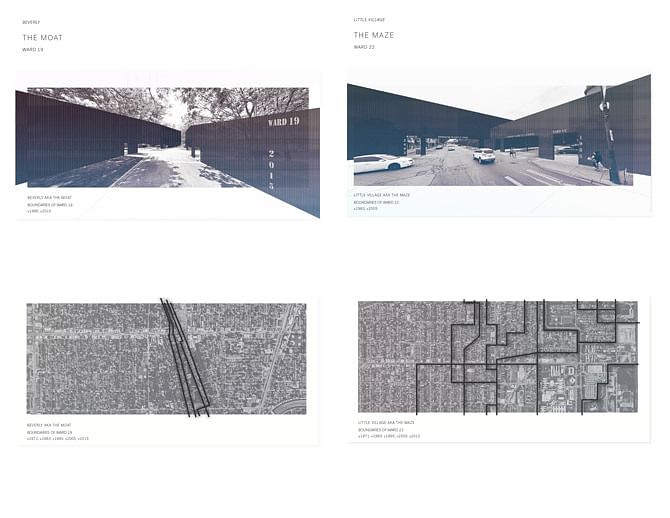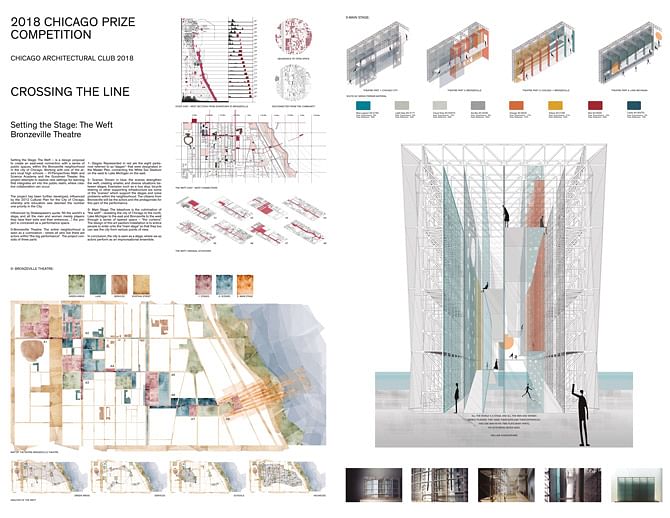“CONNECT THE DOTS” wins 2018 Chicago Prize: Crossing the Line competition
By Justine Testado|
Friday, May 17, 2019

Related
“CONNECT THE DOTS” was recently revealed as the winning entry of the 2018 Chicago Prize. Based on the Chicago Architectural Club's yearlong “Crossing the Line” theme, the latest edition of the biennial competition challenged participants to “select one or multiple material and/or immaterial lines that form Chicago, identify their significance, and propose a design that addresses the urban ramifications of these lines.” In light of the centenary of the Chicago Race Riot of 1919, “Crossing the Line” explores the physical and conceptual implications of different types of lines and their impact on the built environment.
The winning team included Megan Wade and Pimpakarn Rattanathumawat of Fieldwork Design Group, and David Schroeder of David Schroeder Architects. Additionally, the jury selected two runners-up and three honorable mentions.
In recent years, previous competition themes included “On the Edge” and “Imagining Obama's Presidential Library”.
Take a gander at the 2018 winning entries!
(cover image) 2018 CHICAGO PRIZE WINNER: “CONNECT THE DOTS” by Megan Wade (Fieldwork Design Group, LLC), Pimpakarn Rattanathumawat (Fieldwork Design Group, LLC), David Schroeder (David Schroeder Architects)
Project summary: “Connect the Dots re-envisions Chicago spatially by reclaiming city parks, boulevards, and parkways as bird and pollinator habitats and establishes migratory routes through policies that prevent pesticide use within Chicago and requires seeding of vacant lots with pollinators. The proposal sets both a spatial and policy-oriented agenda to maintain and enliven needed ecologies both for the benefit of all species.”

RUNNER UP: “COMMUNITY AMPLIFIED STATIONS” by Mejay Gula, Nick Wylie
Summary: “The project looks at the Chicago River as an opportunity to address through design the division and inequity between Chicago’s neighborhoods - primarily through the agent of speech. The project catalogues the Bridgehouses that line the Chicago River and proposes their adaptive reuse as Community Amplified Stations - spaces for local radio services that can form an interactive network between Chicago’s historically segregated communities.”

RUNNER UP: “CROSSING THE SKYLINE” by Aneesha Dharwadker (Chicago Design Office)
Summary: “The project zooms in to the architecture of city prisons as isolated islands surrounded by hard walls and the incarcerated themselves as surrounded by invisible lines once they reenter their communities. Within Chicago’s context, the project examines the Metropolitan Correctional Facility and proposes a connection through the skyline to the Harold Washington Library - bridging what could be considered the most physically secure and separated to the most freely public and engaged architectural institution.”

HONORABLE MENTION: THE MOAT AND THE MAZE by Matthew Okazaki
Summary: “The project materializes the invisible lines of Chicago Wards. Given the local governing power of wards which control zoning policies, public services, and facilities like libraries, police stations, schools and parks, the physical demarcation of these spaces have a profound impact on local neighborhoods. The Mote and the Maze focus on two Chicago neighborhoods - Beverly and Little Village - both of which, when the invisible lines of the wards are made present, make physical how the Beverly community can be seen a mote district, while Little Village’s ward lines creates a maze-like zone where the community is fractured into incoherent pieces. This proposal raises questions about the utility of wards, their impact on communities, both physically and socially, ultimately whether these divisions are beneficial.”

HONORABLE MENTION: DRAWING A MARATHON by Joseph Altshuler & Zachary Morrison (Could Be Architecture)
Summary: “Crossing the Finish Line proposes re-routing the Chicago Marathon through a greater breadth of the city’s neighborhoods, each year drawing a new line to race through a cultural cross sections that speak to an annual theme. Proposed routes include: the Wild Wild Western Run down Chicago’s longest continuous North-South street; The RIP or Run in Peace which routes the city’s cemeteries and culturally significant landscapes; and the Gastro-thon which routes through Chicago’s most celebrated culinary districts. For each of these themes, a series of bespoke kiosks line the route providing amenities for both racers and the event’s 1.7 million spectators, the Chicago Marathon becomes a vehicle to dissect, activate, and celebrate the significant plurality of geography and peoplehood that make up Chicago.”

HONORABLE MENTION: SETTING THE STAGE: THE WEFT by Ricardo Fernandez Gonzalez
Summary: “Setting the stage: The Weft proposes an east-west connection in the Bronzville’s neighborhood to integrate art and learning into the public realm for creative collaboration. The proposal approaches the neighborhood of Bronzville as a community of actors. The project re-assigns 8 parks as ‘stages’ that connect east-west from Lake Michigan to the White Sox Stadium. Scenes such as bus stops and bike stations bridge the stages as serves spaces for interaction among the community of actors. By re-envisioning the neighborhood’s public spaces where the community serve as protagonists in the life and performance of the neighborhood, this project seeks to reinvigorate creativity and arts into the daily lives of how people experience the city.”
Jury members:
Carol Ross Barney FAIA, Founder Ross Barney Architects; Monica Chadha, AIA, Founder of Civic Projects; Kevin Harrington, PhD, Professor Emeritus IIT, Author; Sarah Herda, Director of the Graham Foundation
You can learn more about the 2018 Chicago Prize here.
RELATED COMPETITION 2018 Chicago Prize Competition: Crossing the Line

RELATED NEWS Closer look at 2016 Chicago Prize: On the Edge winner, “Lattices on the Drive”


Share
0 Comments
Comment as :